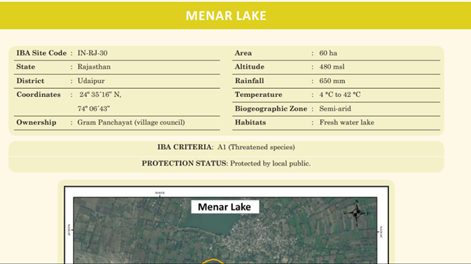

Context
Menar in Udaipur district is set to be notified as Rajasthan's new wetland.
About
- The two lakes in the village – the Brahma and Dhandh – play host to a large number of migratory birds in the winter season every year.
- The State government's Forest Department has initiated the process for notification of Menar as a wetland, which will recognise its role in the storage of sediment and nutrients and enable the local authorities to maintain the Brahma and Dhandh lakes.
- With the status of wetland, the two lakes will be strengthened for increasing vegetation of aquatic plants and protecting biodiversity.
- Observed Species:
- More than 150 species of local and migratory birds inhabit the two lakes in the winter season.
- They include Greater Flamingo, White-tailed Lapwing, Pelican, Marsh Harrier, Bar-headed Goose, Common Teal, Greenshank, Pintail, Wagtail, Green Sandpiper and Red-wattled Lapwing.
- Bird lovers and tourists flock to the village after the arrival of migratory birds from as far as Central Asia, Europe and Mongolia.
- Other Ramsar Sites in Rajasthan:
At present, Rajasthan has two wetlands recognised as Ramsar sites –
-
- Keoladeo Ghana in Bharatpur district
- Sambhar Salt Lake in Jaipur district.

About Wetlands
- Wetlands are land areas that are saturated or flooded with water either permanently or seasonally.
- Inland wetlands include marshes, ponds, lakes, fens, rivers, floodplains, and swamps.
- Coastal wetlandsinclude saltwater marshes, estuaries, mangroves, lagoons, and even coral reefs. Fishponds, rice paddies, and saltpans are human-made wetlands.
- Ramsar Convention
- The Ramsar Convention is an international agreement promoting the conservation of wetlands.
- The Convention was adopted at Ramsar in Iran in 1971 and came into force in 1975. Almost 90% of the UN member states are part of the Convention.

